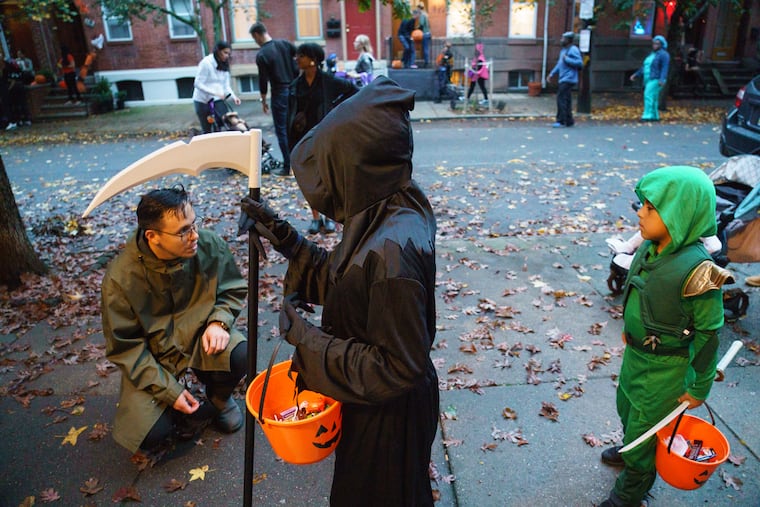Forget Halloween myths like rainbow fentanyl. Drivers pose the biggest risk to children.
Children are more likely to be struck and killed by a car on Halloween than any other day of the year.

It’s the latest scary Halloween story: Sickos might put “rainbow fentanyl” in candy and hand it out to trick-or-treating children.
Experts say the chance of that happening is about 0%.
The biggest Oct. 31 threat to kids is more commonplace: traffic. A number of studies show that children are more likely to be struck and killed by a car on the holiday than on any other day of the year.
Yet rainbow fentanyl, the latest Halloween poisoning panic, grabs outsized attention. In years past it was kids getting pot gummies with their Swedish Fish, sadists putting LSD in candy bars, treats booby-trapped by razor blades, or a number of other horrors.
“A contemporary legend is harder to kill than a werewolf,” said Joel Best, a professor of sociology and criminology at the University of Delaware who has studied the phenomenon for decades.
» READ MORE: ‘Rainbow fentanyl’ panic is obscuring the real dangers of a contaminated drug supply, experts say
He has not found evidence of any child killed or seriously hurt by contaminated treats picked up while trick-or-treating, based on examinations of at least 200 media reports of incidents from 1958 through 2021.
Scary: Cars vs. pedestrians
But on Oct. 31, millions of children flood neighborhoods to walk door-to-door collecting candy, usually at dusk, historically the most dangerous time of day for pedestrians. They wear costumes that in some cases are not very visible and masks that can restrict peripheral vision. Teenagers and adults celebrate Halloween, too. And many drink alcohol while doing so.
The overall risk of a pedestrian dying in a traffic crash was 43% higher on Halloween evenings compared with “control” evenings one week before the holiday and one week after, according to research on 42 years of fatal accidents published in 2019 in JAMA Pediatrics, a medical journal.
Children walking on Halloween were at greater risk. In fact, the authors found child pedestrians 4 to 8 years old were about 10 times more likely to be killed by a vehicle on a Halloween evening than on other fall evenings.
Crash factors such as drunken-driving offenses and the size of the vehicle did not differ on Halloween, the authors concluded. The researchers, physicians at the University of British Columbia and the University of Toronto, based their findings on statistical analysis of about 1.6 million fatal crashes of all types reported by police to the U.S. Department of Transportation between 1975 and 2016.
In 1997, the CDC found child pedestrian deaths increased fourfold on Halloween compared with every other evening. Like the JAMA report, the conclusion was based on data from the federal Accident Reporting system of the National Highway Traffic Safety Administration — in this case, from 1975 to 1996.
While the risk to children from crashes is worth addressing, the absolute number of deaths is low. A Washington Post analysis found 54 pedestrians younger than 18 were struck and killed by an automobile on Halloween from 2004 through 2018. By comparison, 16 child pedestrians are killed on a typical day, the newspaper said.
Most Halloween traffic-safety advice focuses on individual celebrators or drivers, but the JAMA authors argue for a broader focus.
They say “deficiencies in the built environment” such as lack of sidewalks and unsafe street crossings, as well as failures in traffic control were most to blame for pedestrian deaths of children on Halloween, after controlling for other possible factors.
Modern road design and more enforcement, including speed cameras in residential areas, would make the streets safer for kids every day, the researchers concluded.
How did the rainbow fentanyl myth blow up?
Best, the University of Delaware scholar, said the fentanyl scare followed a typical course for a Halloween legend.
It began with a Drug Enforcement Administration news release Aug. 30 noting that agents and local police had seized pastel-colored fentanyl pills in a number of states. The release went on to speculate drug traffickers were targeting younger people with pills designed to resemble candy — though DEA made no mention of Halloween.
Fentanyl is a synthetic opioid 50 times more powerful than heroin. Dealers add it to illicit street drugs, fueling a pandemic of overdoses in the United States, including in Philadelphia.
» READ MORE: Chill out, parents. Your kids’ Halloween candy is almost certainly safe. | Opinion
The story accelerated after Ronna McDaniel, chair of the Republican National Committee, said on Fox News that mothers had to worry about rainbow fentanyl showing up in Halloween candy, citing a porous southern border.
Political commentators picked up the idea. Then a group of Republican U.S. senators made a public service announcement about the threat.
And on Oct. 19 authorities seized 12,000 fentanyl pills packaged in candy boxes at Los Angeles International Airport.
The Los Angeles Sheriff’s Office warned parents to check their kids’ Halloween candy. Other law enforcement agencies around the country have also tied fentanyl to the holiday.
It’s simply illogical to say fentanyl will be passed out on Halloween, Best said. Drug dealing is a business.
“If you think about it, it’s idiotic,” he said. “Drug dealers probably aren’t going to do it. First, fentanyl could easily kill a child. Say a kid does get addicted from that one experience. What are they doing to do, go after his lunch money? It’s a terrible business model.”